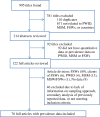Epidemiology of HIV among female sex workers, their clients, men who have sex with men and people who inject drugs in West and Central Africa
- PMID: 24321113
- PMCID: PMC3852130
- DOI: 10.7448/IAS.16.4.18751
Epidemiology of HIV among female sex workers, their clients, men who have sex with men and people who inject drugs in West and Central Africa
Abstract
Introduction: The West and Central Africa (WCA) sub-region is the most populous region of sub-Saharan Africa (SSA), with an estimated population of 356 million living in 24 countries. The HIV epidemic in WCA appears to have distinct dynamics compared to the rest of SSA, being more concentrated among key populations such as female sex workers (FSWs), men who have sex with men (MSM), people who inject drugs (PWID) and clients of FSWs. To explore the epidemiology of HIV in the region, a systematic review of HIV literature among key populations in WCA was conducted since the onset of the HIV epidemic.
Methods: We searched the databases PubMed, CINAHL and others for peer-reviewed articles regarding FSWs, MSM and PWID in 24 countries with no date restriction. Inclusion criteria were sensitive and focused on inclusion of any HIV prevalence data among key populations. HIV prevalence was pooled, and in each country key themes were extracted from the literature.
Results: The search generated 885 titles, 214 abstracts and 122 full articles, of which 76 met inclusion and exclusion criteria providing HIV prevalence data. There were 60 articles characterizing the burden of disease among FSWs, eight for their clients, one for both, six for MSM and one for PWID. The pooled HIV prevalence among FSWs was 34.9% (n=14,388/41,270), among their clients was 7.3% (n=435/5986), among MSM was 17.7% (n=656/3714) and among PWID from one study in Nigeria was 3.8% (n=56/1459).
Conclusions: The disproportionate burden of HIV among FSWs appears to be consistent from the beginning of the HIV epidemic in WCA. While there are less data for other key populations such as clients of FSWs and MSM, the prevalence of HIV is higher among these men compared to other men in the region. There have been sporadic reports among PWID, but limited research on the burden of HIV among these men and women. These data affirm that the HIV epidemic in WCA appears to be far more concentrated among key populations than the epidemics in Southern and Eastern Africa. Evidence-based HIV prevention, treatment and care programmes in WCA should focus on engaging populations with the greatest burden of disease in the continuum of HIV care.
Keywords: Central Africa; HIV epidemiology; West Africa; men who have sex with men; people who inject drugs; prevalence; risk factors; sex work.
Figures
References
-
- Bank TW. GPE Open Data Project 2012. Washington, DC: World Bank; 2012. Population estimates 2008–2012.
-
- Bank TW. GPE Open Data Project. Washington, DC: World Bank; 2013. Economic assessment of lending groups, world atlas method.
-
- Agyei-Mensah S. Twelve years of HIV/AIDS in Ghana: puzzles of interpretation. Can J Afr Stud. 2001;35(3):441–72. - PubMed
-
- Gisselquist D. Emergence of the HIV type 1 epidemic in the twentieth century: comparing hypotheses to evidence. AIDS Res Hum Retroviruses. 2003;19(12):1071–8. - PubMed
-
- UNAIDS. West and Central Africa: towards universal access to prevention, care and treatment; Dakar, Senegal: UNAIDS/0829E/JC1585E; 2008.
Publication types
MeSH terms
LinkOut - more resources
Full Text Sources
Other Literature Sources
Medical
Research Materials
Miscellaneous



